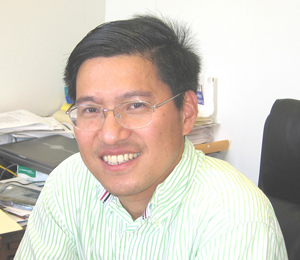Huangen Ding
Professor
BMB Division
PhD: University of Pennsylvania, 1995
Phone: 225-578-4797
Lab Phone: 225-578-4731
Office: 608 Life Sciences Building
Lab: 601/606/607/608 Life Sciences Building
E-mail: hding@lsu.edu
Area of Research Interest
Iron-sulfur proteins play essential roles in a wide range of physiological processes, including DNA replication and repair, RNA modification, protein and coenzyme biosynthesis, energy metabolism, and signal transduction. Despite their importance, the precise mechanisms underlying iron-sulfur cluster assembly in proteins remain incompletely understood. Our research aims to elucidate how intracellular free iron is mobilized for cluster assembly and how iron homeostasis is regulated through the ferric uptake regulator (Fur) in bacteria. In addition, we are investigating the functional roles of iron-sulfur clusters in the human mitochondrial outer membrane protein mitoNEET. MitoNEET coordinates a redox-active [2Fe-2S] cluster at its C-terminal cytosolic domain and has been implicated in several human diseases, including breast cancer, type II diabetes, and neurodegenerative disorders. We have identified mitoNEET as a novel redox enzyme that catalyzes NADH oxidation in the cytosol and enhances glycolytic activity in human cells. Our ongoing work focuses on identifying small molecules that target mitoNEET to modulate mitochondrial energy metabolism in human cells.
Selected Publications
Najafi, F., Purcell, A. G., Homes, F., H., & Ding, H. (2025) Binding of a [2Fe-2S] cluster drives dimerization of ferric uptake regulator (Fur) in Escherichia coli. J. Biol. Chem. 301(1):110702. doi: 10.1016/j.jbc.2025.110702
Li, C., Liang, Z., Vontz, G., Kent, C., Liu, L., Dahal, D., Ma, W., Zabaleta, Z., Cai, G., Zhou, J., Ding, H., & Shen Q. (2025) Exploring CISD1 as a Multifaceted Biomarker in Cancer: Implications for Diagnosis, Prognosis, and Immunotherapeutic Response. Gen & Dis. 12 (6) 101677. doi.org/10.1016/j.gendis.2025.101677
Fontenot, C. R., Hoepner, T., Xiong, J. , Ding, H. , and Popescu, C.V. (2025) Mössbauer studies of the redox state of the ferric uptake regulator [2Fe-2S]2+ cluster in Escherichia coli. J. Inorg. Biochem. 270:112928. doi: 10.1016/j.jinorgbio.2025.112928.
Purcell, A., G., Fontenot, C. R., and Ding, H. (2024) Iron-sulfur cluster assembly scaffold protein IscU is required for activation of ferric uptake regulator (Fur) in Escherichia coli. PMID: 38452854. doi: 10.1016/j.jbc.2024.107142.
Fontenot, C. R. & Ding, H. (2023) The C-terminal domain of the ferric uptake regulator (Fur) binds a [2Fe-2S] cluster to sense the intracellular free iron content in Escherichia coli. Biometals PMID: 37344741 doi: 10.1007/s10534-023-00517-6.
Fontenot, C. R. & Ding, H. (2023) Ferric uptake regulator (Fur) binds a [2Fe-2S] cluster to regulate intracellular iron homeostasis in Escherichia coli. J. Biological Chem. 299, 104748. PMID: 37100285 PMC10318462 doi: 10.1016/j.jbc.2023.104748.
Tasnim, H. & Ding, H. (2022) Electron transfer activity of the nanodisc-bound mitochondrial outer membrane protein mitoNEET. Free Radic. Biol. Med. 187, 50-58. PMID: 35609862 DOI: 10.1016/j.freeradbiomed.2022.05.011.
Fontenot, C. R., Cheng, Z., & Ding, H. (2022) Nitric oxide reversibly binds the reduced [2Fe-2S] cluster in mitochondrial outer membrane protein mitoNEET and inhibits electron transfer activity. Frontiers in Molecular Biosciences. https://doi.org/10.3389/fmolb.2022.995421.
Fontenot, C. R. & Ding, H. (2022) Ferric uptake regulators (Fur) from Vibrio cholerae and Helicobacter pylori bind a [2Fe–2S] cluster in response to elevation of intracellular free iron content. Biometals, 35, 591-600.
Fontenot, C. R., Tasnim, H., Valdes, K. A., Popescu, C. V. & Ding, H. (2020) Ferric uptake regulator (Fur) reversibly binds a [2Fe-2S] cluster to sense intracellular iron homeostasis in Escherichia coli. J. Biol. Chem. 295, 15454-15463.
Tasnim, H., Landry, A. P., Fontenot, C. R., & Ding, H. (2020) Exploring the FMN binding site in the mitochondrial outer membrane protein mitoNEET. Free Radic. Biol. Med. 156, 11-19.
Wang, Y., Lee, Y., & Ding, H., (2019) Light-induced release of nitric oxide from the nitric oxide-bound CDGSH-type [2Fe-2S] clusters in mitochondrial protein Miner2. Nitric Oxide 89, 96-103.
Li, X., Wang, Y., Tan, G., Lyu, J. & Ding, H. (2018) Electron transfer kinetics of the mitochondrial outer membrane protein mitoNEET. Free Radic. Biol. Med. 121, 98-104.
Tan G, Yang J, Li T, Zhao J, Sun S, Li X, Lin C, Li J, Zhou H, Lyu J, & Ding H. (2017) Anaerobic copper toxicity and iron-sulfur cluster biogenesis in Escherichia coli. Appl Environ Microbiol. 83(16). e00867-17.
Wang, Y., Landry, A. P. & Ding, H. (2017) The mitochondrial outer membrane protein mitoNEET is a redox enzyme catalyzing electron transfer from FMNH2 to oxygen or ubiquinone. J. Biol. Chem. 292:10061-1006.
Cheng, Z., Landry, A. P., Wang, Y. & Ding, H. (2017) Binding of nitric oxide in the CDGSH-type [2Fe-2S] clusters of human mitochondrial protein Miner2. J. Biol. Chem.292, 3146-3153.
Landry, A. P., Wang, Y., Cheng, Z., Crochet, R.B., Lee, Y.H., & Ding, H. (2017) Flavin nucleotides act as electron shuttles mediating reduction of the [2Fe-2S] clusters in mitochondrial outer membrane protein mitoNEET. Free Radic. Biol. Med. 102, 240-247.
Ding, H. (2016) Iron Homeostasis and Iron-Sulfur Cluster Assembly in Escherichia coli in book Stress and Environmental Regulation of Gene Expression and Adaptation in Bacteria Publisher, Wiley-Blackwell. pp. 203-214.
Yang, J., Tan, G., Zhang, T., White, R. H., Lu, J., & Ding H. (2015) Deletion of the proposed iron chaperones IscA/SufA results in accumulation of a red intermediate cysteine desulfurase IscS in Escherichia coli. J. Biol. Chem. 290, 14226-14234.
Landry, A. P., Cheng, Z., & Ding, H. (2015) Reduction of mitochondrial protein mitoNEET [2Fe-2S] clusters by human glutathione reductase. Free Radic. Biol. Med. 81, 119-127.
Huang, C. Y, Abe, Y., Ding, H. & Chung, I.F. (2015) Helicase and its interacting factors: regulation mechanism, characterization, structure, and application for drug design. Biomed. Res. Int. 2015, 909047